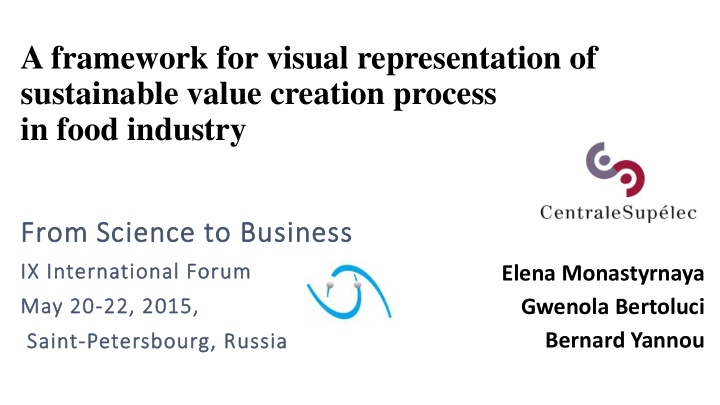



A framework for visual representation of sustainable value creation process in food industry From Science to Business IX International Forum Elena Monastyrnaya May 20-22, 2015, Gwenola Bertoluci Bernard Yannou Saint-Petersbourg, Russia
Sustainable food supply chains (Elkington 2009) (Hawkes 2009) Sustainable business is « one that contributes to sustainable development by delivering simultaneously 2 economic, social and environmental benefits » ( Hart and Milstein 2003 )
Issues for sustainability in food supply chains Issues Consequences Studies Complex multinational context, Information asymmetry, Fritz and Shiefer 2009, Heikkurinen et al. 2012 Long uncontrollable supply chains Food contamination Danger for local farmers and Eaton and Shepherd 2001, Increased competition Sari Forsman-Hugg et al. producers 2007, Hawkes and Ruel 2011 Increased concentration in Stevenson and Pirog 2008, Power imbalances CIAA 2010, Hartmann 2011 processing and purchasing Weather vagaries, Tilman et al. 2002, KPMG Increased risks for farmers 2013 climatic changes Conflicting interests Hart and Milstein 2003, Sari Complexity of sustainability Forsman-Hugg et al. 2007, Misuses of resources or PR tool Detre and Gunderson 2011, concept Bocken et al. 2013 for managers 3
Sustainable indicators Dimensions of corporate social responsibility in food industry Global Reporting Initiative (2006) ( Maloni and Brown, 2008 ) 4
Problem • Managers disagree about specific meaning of business sustainability (Hart and Milstein 2003) • Focus on environmental and economic dimensions (Katajajuuri et al. 2007, Seuring 2013, Bocken et al. 2014) • Public relation tool (Rana et al. 2009, Heikkurinen et al. 2012) Practice Theory Bocken et al. 2014, Craig and Rogers 2007 5
Methodology Objective: to create a synthetic framework that embeds all three dimensions of sustainability and displays supply chain management practices and sustainable values created within the food supply chain. - Deductive approach Three case studies • Bleu Blanc Cœur (France) - Database keyword search • Science Direct • Terrena – Système U (France) • Springer • Pekan Baru Project (Singapore) • Web of Science • Google Scholar • FAO, KPMG, APEC… 6
Conceptual representation of value creation process in food supply chains Assuring efficient use of Resources and Capabilities Identifying Contributions of each Formulating Value Proposition Supply Chain actor according to existing needs for sustainable value creation 7
Concepts and tools for business sustainability Authors Name of the Model/Concept Shared Value Concept Porter and Kramer (2011) Framework of Sustainable Supply Chain Management Craig and Rogers (2007) Conceptual Sustainable Value Framework Hart and Milstein (2003) tools Laszlo (2008) Sustainable Value Framework Demand Supply Chain Approach Lassale de Salins (2014) Business Model Canvas Osterwalder et al. (2010) Business Balanced Scorecard Kaplan and Norton (1996) modelling tools Value Mapping Tool Bocken et al. Equilibrium models Quantitative Life cycle assessment Quantitative approaches (Seuring, 2013) approaches Multicriteria decision making 8 Analytical hierarchy process
Supply chain management (Beske et al. 2014) Strategic orientation Triple bottom line Model creation Long-term relationship Continuity Partner development Partner selection Joint development Technical integration Collaboration Logistical integration Enhanced communication Individual monitoring Risk Management Pressure group management Standards and certification Learning Stakeholder management Pro-activity Innovation Life cycle assessment 9 (Heikkurinen et al. 2012) (Maloni and Brown 2008)
Food supply chain sustainability framework 10
Cases of sustainable food supply chains Milk and Meat products with improved lipid profile and Primary Manufacturers Distributors (N) less environmental damage Producers (N) (N) Primary Meat products with improved lipid profile Distributors (1) Producers (1) and less environmental damage Reliable source of fresh Primary Distributors (1) vegetables, new working places, Producers (N) reduced environmental impact 11
12
Conclusion Synthetic framework that allows representation of sustainable food supply chains is developed to help: Practitioners Supply chains Next steps: Associations in food industry • Continue theoretical studies • Apply to more cases • picture of current sustainability • Interview food industry experts • Develop a framework to assist • convey it to stakeholders sustainable food supply chains design • assure a better communication • achieve greater effects of joint sustainable performance. 13
A framework for visual representation of sustainable value creation process in food industry From Science to Business IX International Forum Elena Monastyrnaya May 20-22, 2015, Gwenola Bertoluci Bernard Yannou Saint-Petersbourg, Russia
Recommend
More recommend